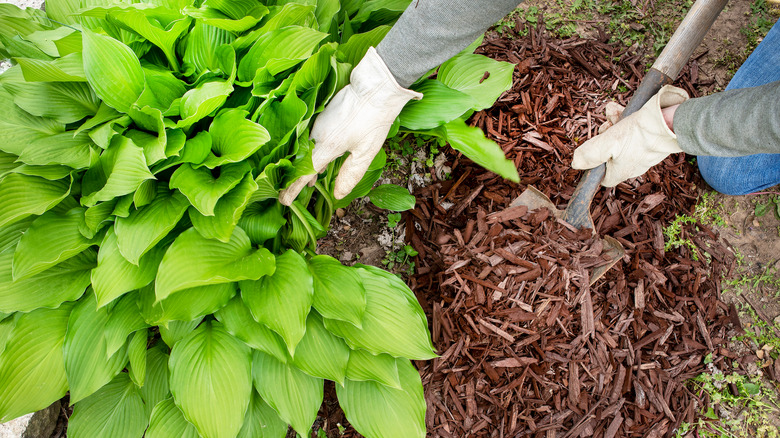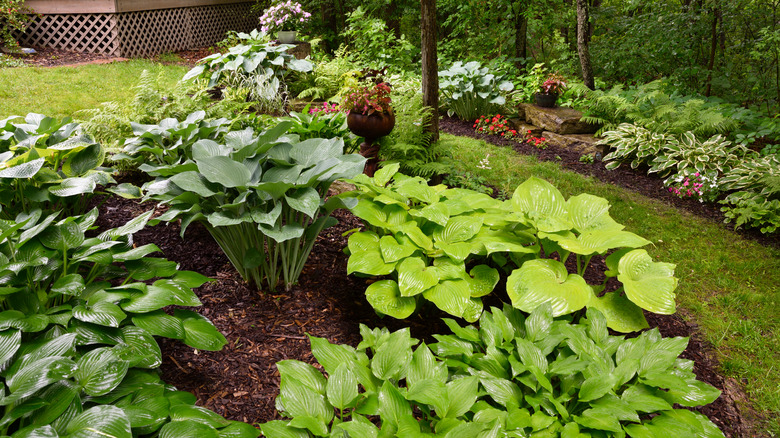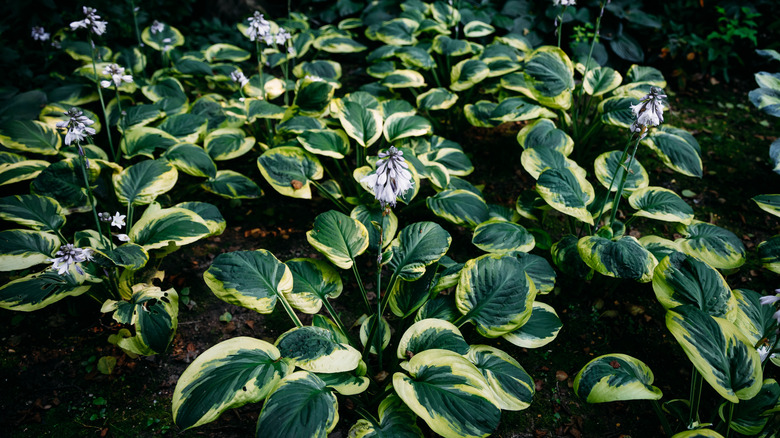How Much Space Does A Hosta Need In The Garden?
If your yard sits largely in the shade, hostas are your garden's saving grace. With dozens of varieties that give dozens of different looks in color, pattern, and shape, you could carpet your lawn in hostas and not lose any visual interest. In fact, you could even use their many patterns to create a graphic display.
Hostas are also great for ground cover; and, in that case, should be planted tightly together to create the desired effect. For using them as border plants, though, as many people do, you'll want to make sure to leave anywhere from 1-4 feet in between each plant, depending on the variety.
There are so many different varieties of hostas that it's impossible to hold them all to a single standard of care. In general, hostas are shade-loving, but varieties with variegated leaves (a multicolored "striped" or "marbled" pattern) produce bolder, brighter colors with greater delineation if they receive a couple of hours of early morning sunlight or dappled sunlight throughout the day.
Similarly, most hostas grow to be between 2-4 feet wide, but there are some that are much larger and others that are dwarf varieties. Keeping in mind how you want them to be showcased in your garden, researching your specific variety's exact care recommendations is always best. However, when you're still in the planning stages, you can use this rule-of-thumb distance of 1-4 feet apart as a guideline.
Plant your hostas with enough space to allow mature growth
Of all the varieties of hostas, several of the most popular — including Striptease, Pathfinder, Wolverine, Emerald Cup, and Patriot — reach a mature width of 24-48 inches. When planning out your landscaping, allow for the full growth of your plants so things don't get too crowded and busy. Bunching your flora too closely together might lead to them failing to thrive, at which point, instead of an overstuffed garden, you have a strained and dying one.
To plant your hostas, you must create a spot to place them that is twice as wide as the root structure itself. So, for small hosta plants (or recently divided ones) with a root system of about 6 inches in diameter, you should dig a hole that's 12 inches wide, but only as deep as the roots themselves. Then, allowing for the eventual maturity of your chosen hosta, place the next hole as far away as you expect it to grow. Naturally, you'll expect the hostas to spread evenly, so only half the plant will spread in any direction; but, if you're placing them beside each other, you have to allow for half of both plants to fill the space.
All hostas love moist, nutrient-rich soil, so work in some composted material with your soil and water regularly until they're well established. If you plant in the early spring, your hostas should be unfurling beautifully by the time early perennials like tulips and daffodils are dying away.
To create a ground cover, plant your hostas closer together
If you have mature trees in your yard, it's possible they create so much shade that grass struggles to grow. Weeds, however, seem to flourish even where grass is sparse. Thankfully, hostas are a great way to address both these issues. As hostas thrive in shady or sun-dappled areas, they are perfectly placed under mature trees as long as they are sufficiently watered. Moreover, as your hostas grow and spread, they tend to crowd out other plants — including weeds. Plus, hostas as ground cover create a beautiful look, whether they're growing ornamentally in a rock garden or organically spreading in a wooded corner of your property.
Smaller hostas are generally the best option for ground cover, and these varieties naturally have a narrower spread in addition to a shorter profile. Obviously, these smaller dimensions allow for tighter spacing; but, to ensure you achieve your desired coverage, space them at the low end of their growth range. For example, a Munchkin Fire hosta has an anticipated mature spread of 1-2 feet. Aim to space them closer to 1 foot apart than 2 for quick coverage of the ground in question without sacrificing the health of the plants.
Use a single variety to create a uniform look, or go with a wide variety of hosta types to make a bold statement. However you use them, hostas are incredibly hardy and versatile enough for almost any landscape design.


